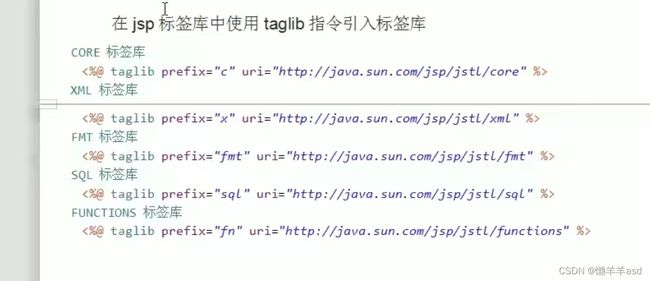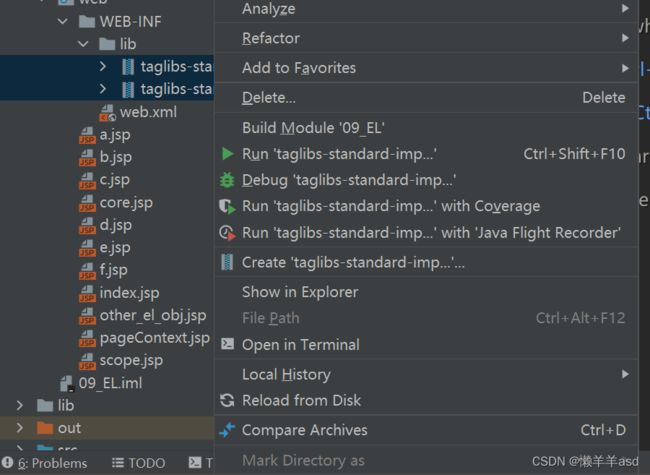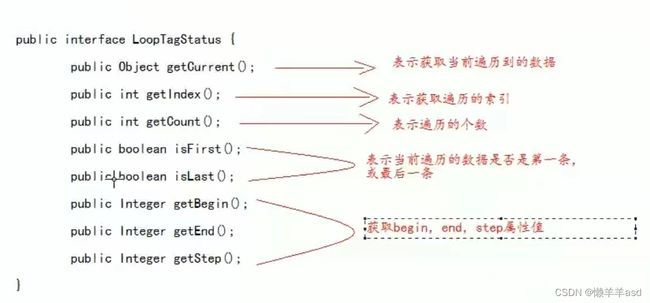【JavaWeb】EL表达式&JSTL标签库
文章目录
- 一.EL表达式⭐️
-
- 1.EL表达式概念及作用
- 2.EL表达式搜索域数据的顺序
- 3.EL表达式输出Bean的普通属性,数组属性,List集合属性,map集合属性
- 4.EL表达式运算
- 5.EL表达式的11个隐含对象
- 二.JSTL标签库⭐️
-
- 1.JSTL标签库的使用步骤
- 2.core核心库使用
一.EL表达式⭐️
1.EL表达式概念及作用
EL表达式的全称:Expression Language(表达式语言)
EL表达式的作用:代替jsp页面中的表达式脚本(由于比jsp的表达式脚本简洁)在jsp页面中进行数据的输出.
EL表达式的格式:${表达式}
EL表达式在输出null值的时候,输出的是空串
jsp表达式脚本输出null值的时候,输出的是null字符串
<%@ page contentType="text/html;charset=UTF-8" language="java" %>
<html>
<head>
<title>Title</title>
</head>
<body>
<%
request.setAttribute("key","值1");
%>
表达式脚本输出key的值是:<%=request.getAttribute("key")%><br/>
EL表达式输出key的值是:${key}
</body>
</html>
2.EL表达式搜索域数据的顺序
EL表达式主要在jsp页面中输出数据.
主要输出域对象中的数据.
注意:当四个域中都有相同的key的数据的时候,EL表达式会按照四个域的从小到大的顺序去进行搜索,找到就输出.
<body>
<%
//pageContext.setAttribute("key","pageContext");
//request.setAttribute("key"," request");
//session.setAttribute("key","session");
//application.setAttribute("key","application");
%>
${key}
</body>
3.EL表达式输出Bean的普通属性,数组属性,List集合属性,map集合属性
示例-输出Person类中的普通属性,数组属性,list集合属性和map集合属性.
public class Person {
private String name;
private String[] phones;
private List<String> cities;
private Map<String,Object> map;
public Person() {
}
public Person(String name, String[] phones, List<String> cities, Map<String, Object> map) {
this.name = name;
this.phones = phones;
this.cities = cities;
this.map = map;
}
public String getName() {
return name;
}
public void setName(String name) {
this.name = name;
}
public String[] getPhones() {
return phones;
}
public void setPhones(String[] phones) {
this.phones = phones;
}
public List<String> getCities() {
return cities;
}
public void setCities(List<String> cities) {
this.cities = cities;
}
public Map<String, Object> getMap() {
return map;
}
public void setMap(Map<String, Object> map) {
this.map = map;
}
@Override
public String toString() {
return "Person{" +
"name=" + name +
", phones=" + Arrays.toString(phones) +
", cities=" + cities +
", map=" + map +
'}';
}
}
<%@ page contentType="text/html;charset=UTF-8" language="java" %>
<html>
<head>
<title>Title</title>
</head>
<body>
<%
Person person = new Person();
person.setName("结果");
person.setPhones(new String[]{"1866666","12333333","154688888"});
List<String> cities = new ArrayList<String>();
cities.add("北京");
cities.add("上海");
cities.add("深圳");
person.setCities(cities);
Map<String,Object> map = new HashMap<>();
map.put("key1","value1");
map.put("key2","value2");
map.put("key3","value3");
person.setMap(map);
pageContext.setAttribute("p",person);
%>
输出Person:${p}<br/>
输出Person的name属性值:${p.name}<br/>
输出Person的phones数组属性值:${p.phones[2]}<br/>
输出Person的cities集合中的元素值:${p.cities}<br/>
输出Person的cities集合中的个别元素值:${p.cities[2]}<br/>
输出Person的Map集合:${p.map}<br/>
输出Person的Map集合中某个key的值:${p.map.key3}<br/>
输出Person的age属性:${p.age}<br/>
</body>
</html>
注意:这里的点运算,实际上是调用类中的get方法.
4.EL表达式运算
${12 == 12}或者${12 eq 12}<br/>
${12 != 12}或者${12 ne 12}<br/>
${12 < 12}或者${12 lt 12}<br/>
${12 > 12}或者${12 gt 12}<br/>
${12 >= 12}或者${12 ge 12}<br/>
${12 <= 12}或者${12 le 12}<br/>
${12 == 12 && 12 > 11}或者${12 == 12 and 12 > 11}<br/>
${12 == 12 || 12 > 11}或者${12 == 12 or 12 > 11}<br/>
${! true}或者${not true}<br/>
(3).算数运算
${12 + 12}<br/>
${12 - 12}<br/>
${12 * 12}<br/>
${12 / 12} 或 ${12 div 12}<br/>
${12 % 12} 或 ${12 mod 12}<br/>
(4).empty运算
可以判断一个数据是否为空,如果为空,则输出true,不为空输出false.
为空的几种情况:
- 值为null的时候
- 值为空串的时候
- 值是Object类型数组,长度为0的时候
- list集合,元素个数为0
- map集合,元素个数为0
<body>
<%
request.setAttribute("emptyNull",null);
request.setAttribute("emptyStr","");
request.setAttribute("emptyArr",new Object[]{});
List<String> list = new ArrayList<>();
request.setAttribute("emptyList",list);
Map<String,Object> map = new HashMap<>();
map.put("key1","value");
request.setAttribute("emptyMap",map);
%>
${empty emptyNull}<br/>
${empty emptyStr}<br/>
${empty emptyArr}<br/>
${empty emptyList}<br/>
${empty emptyMap}<br/>
</body>
(5).三元运算
表达式1 ? 表达式2 : 表达式3
如果1为真,则执行2,否则执行3
(6)."."点运算和[]中括号运算符
- 点运算,可以输出
Bean对象中某个属性的值. - 中括号运算,可以输出
有序集合中某个元素的值,还可以输出map集合中key里含有特殊字符的key的值.
<body>
<%
Map<String,Object> map = new HashMap<>();
map.put("a.a.a","aaaValue");
map.put("bbb","bbbValue");
map.put("ccc","cccValue");
request.setAttribute("map",map);
%>
${map['a.a.a']}<br/>
${map.bbb}<br/>
</body>
5.EL表达式的11个隐含对象
这些隐含对象,是EL表达式中自己定义的,可以直接使用.
- EL获取四个特定域中的属性
变量:pageScope类型:Map作用:可以获取pageContext域中的数据.
变量:requestScope类型:Map作用:可以获取Request域中的数据.
变量:sessionScope类型:Map作用:可以获取Session域中的数据.
变量:applicationScope类型:Map作用:可以获取ServletContext域中的数据.
<body>
<%
pageContext.setAttribute("key1","pageContext1");
request.setAttribute("key1","request");
session.setAttribute("key1","session");
application.setAttribute("key1","application");
%>
${pageScope.key1}<br/>
${requestScope.key1}
</body>
- pageContext对象的使用
变量:pageContext 类型:PageContextlmpl 作用:可以获取jsp中的九大内置对象.
<body>
<%--
request.getScheme() 可以获取请求的协议
request.getServerName() 可以获取请求的服务器ip或域名
request.getServerPort() 可以获取请求的服务器端口号
getContextPath() 可以获取当前工程路径
request.getMethod() 可以获取请求的方式(GET/POST)
request.getRemoteHost() 可以获取客户端的ip地址
request.getId() 可以获取会话的唯一标识
--%>
<%
//pageContext.setAttribute("req",request);
%>
1.协议:${pageContext.request.scheme}<br/>
2.服务器ip:${pageContext.request.serverName}<br/>
3.服务器端口号:${pageContext.request.serverPort}<br/>
4.获取当前工程路径:${pageContext.request.contextPath}<br/>
5.获取请求的方式:${pageContext.request.method}<br/>
6.获取客户端的ip地址:${pageContext.request.remoteHost}<br/>
7.获取会话的唯一标识:${pageContext.session.id}<br/>
</body>
- EL表达式其他隐含对象的使用
变量:param类型:Map作用:可以获取请求参数的值
变量:paramValues类型:Map作用:可以获取多个请求参数的值
变量:header类型:Map作用:可以获取请求头的信息
变量:headerValues类型:Map作用:可以获取请求头的信息,多个值的情况
变量:cookie类型:Map作用:可以获取当前请求的Cookie信息
变量:initParam类型:Map作用:可以获取在web.xml中配置的 context-param上下文参数
<body>
输出请求参数username的值:${param.username}<br/>
输出请求参数password的值:${param.password}<br/>
输出请求参数username的值:${paramValues.username[0]}<br/>
输出请求参数hobby的值:${paramValues.hobby[0]}<br/>
输出请求参数hobby的值:${paramValues.hobby[1]}<br/>
<hr>
输出请求头【User-Agent】的值:${header['User-Agent']}<br/>
输出请求头【Connection】的值:${header['Connection']}<br/>
输出请求头【Connection】的值:${header.Connection}<br/>
输出请求头【User-Agent】的值:${headerValues['User-Agent'][0]}<br/>
<hr>
获取Cookie的名称:${cookie.JSESSIONID.name}<br/>
获取Cookie的值:${cookie.JSESSIONID.value}<br/>
<hr>
${initParam}<br/>
${initParam.username}<br/>
输出<context-param>username的值: ${initParam.username}<br/>
</body>
二.JSTL标签库⭐️
JSTL标签库 全称是指 JSP Standard Tag Library JSP标准标签库.
作用:代替jsp页面的代码脚本,使得整个jsp页面变得更加简洁.
1.JSTL标签库的使用步骤
(1).先导入jstl标签库的jar包
(2).使用taglib指令引入标签库
<%@ taglib prefix="c" uri="http://java.sun.com/jsp/jstl/core" %>
<%--
Created by IntelliJ IDEA.
User: asus
Date: 2022/11/15
Time: 10:39
To change this template use File | Settings | File Templates.
--%>
<%@ page contentType="text/html;charset=UTF-8" language="java" %>
<html>
<head>
<title>Title</title>
</head>
<body>
<c:forEach end=""></c:forEach>
</body>
</html>
2.core核心库使用
(1).
作用:set标签可以往域中保存数据.
<body>
<%--
域对象.setAttribute(key,value);
scope 属性设置保存到哪个域
page 表示PageContext域
request 表示Request域
session 表示Session域
application 表示ServletContext域
var 设置key是多少
value 设置值
--%>
保存之前: ${requestScope.abc}<br/>
<c:set scope="request" var="abc" value="abcValue" />
保存之后: ${requestScope.abc}<br/>
</body>
(2).
作用:用来做if判断.
<body>
<%--
test属性表示判断条件(用EL表达式输出)
--%>
<c:if test="${12 == 12}">
<h1>12 == 12</h1>
</c:if>
</body>
(3).
作用:多路判断,跟switch,case,default非常接近.
<%@ taglib prefix="c" uri="http://java.sun.com/jsp/jstl/core" %>
<%--
Created by IntelliJ IDEA.
User: asus
Date: 2022/11/15
Time: 10:39
To change this template use File | Settings | File Templates.
--%>
<%@ page contentType="text/html;charset=UTF-8" language="java" %>
<html>
<head>
<title>Title</title>
</head>
<body>
<%--
choose标签开始选择判断
when标签表示每一种判断情况
test属性表示当前这种判断情况的值
otherwise标签表示剩下的情况
--%>
<%
request.setAttribute("height",178);
%>
<c:choose>
<c:when test="${requestScope.height > 190}">
<h2>巨人</h2>
</c:when>
<c:when test="${requestScope.height > 180}">
<h2>很高</h2>
</c:when>
<c:when test="${requestScope.height > 170}">
<h2>还可以</h2>
</c:when>
<c:otherwise>
<c:choose>
<c:when test="${requestScope.height > 160}" >
<h3>大于160</h3>
</c:when>
</c:choose>
</c:otherwise>
</c:choose>
</body>
</html>
注意:otherwise和when都必须在choose标签内,when也可以在otherwise内,但必须有choose的包裹.
(4).
作用:遍历输出使用.
<body>
<%--
begin 属性设置开始的索引
end 属性设置结束的索引
var 属性表示循环的变量(也是当前正在遍历到的数据)
items 表示遍历的数据源(遍历的集合)
step 属性表示遍历的步长值
varStatus 属性表示当前遍历到的数据的状态
--%>
<%-- 1.遍历输出1—10 --%>
<table>
<c:forEach begin="1" end="10" var="i">
<tr>
<td>第${i}行</td>
</tr>
</c:forEach>
</table>
<hr>
<%-- 2.遍历Object数组 --%>
<%
request.setAttribute("arr",new String[]{"123456","456789","123789"});
%>
<c:forEach items="${requestScope.arr}" var="item">
${item}<br/>
</c:forEach>
<hr>
<%-- 3.遍历Map集合 --%>
<%
Map<String, Object> map = new HashMap<String, Object>();
map.put("key1","value1");
map.put("key2","value2");
map.put("key3","value3");
request.setAttribute("map",map);
%>
<c:forEach items="${requestScope.map}" var="entry">
<h1>${entry}</h1>
<h1>${entry.key}</h1>
<h1>${entry.value}</h1>
</c:forEach>
<hr>
<%-- 4.遍历List集合 --%>
<%
List<Student> studentArrayList = new ArrayList<Student>();
for(int i = 1;i <= 10;i++){
studentArrayList.add(new Student(i,"username" + i,"pass" + i,18 + i,"phone" + i));
}
request.setAttribute("stu",studentArrayList);
%>
<table>
<tr>
<th>编号</th>
<th>用户名</th>
<th>密码</th>
<th>年龄</th>
<th>电话</th>
<th>操做1</th>
<th>操做2</th>
</tr>
<c:forEach begin="2" end="7" items="${requestScope.stu}" var="item" varStatus="status" step="2">
<tr>
<td>${item.id}</td>
<td>${item.username}</td>
<td>${item.password}</td>
<td>${item.age}</td>
<td>${item.phone}</td>
<td>${status.step}</td>
<td>${status.first}</td>
</tr>
</c:forEach>
</table>
</body>






